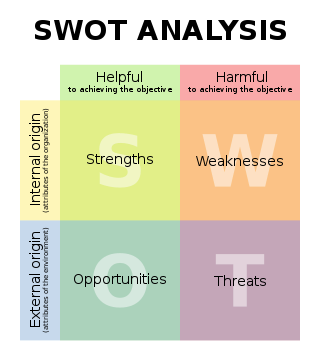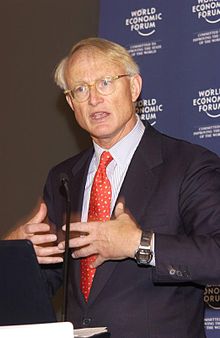Strategy is a general plan to achieve one or more long-term or overall goals under conditions of uncertainty. In the sense of the "art of the general", which included several subsets of skills including military tactics, siegecraft, logistics etc., the term came into use in the 6th century C.E. in Eastern Roman terminology, and was translated into Western vernacular languages only in the 18th century. From then until the 20th century, the word "strategy" came to denote "a comprehensive way to try to pursue political ends, including the threat or actual use of force, in a dialectic of wills" in a military conflict, in which both adversaries interact.
In the field of management, strategic management involves the formulation and implementation of the major goals and initiatives taken by an organization's managers on behalf of stakeholders, based on consideration of resources and an assessment of the internal and external environments in which the organization operates. Strategic management provides overall direction to an enterprise and involves specifying the organization's objectives, developing policies and plans to achieve those objectives, and then allocating resources to implement the plans. Academics and practicing managers have developed numerous models and frameworks to assist in strategic decision-making in the context of complex environments and competitive dynamics. Strategic management is not static in nature; the models can include a feedback loop to monitor execution and to inform the next round of planning.
In business, a competitive advantage is an attribute that allows an organization to outperform its competitors.
Competitive analysis in marketing and strategic management is an assessment of the strengths and weaknesses of current and potential competitors. This analysis provides both an offensive and defensive strategic context to identify opportunities and threats. Profiling combines all of the relevant sources of competitor analysis into one framework in the support of efficient and effective strategy formulation, implementation, monitoring and adjustment.

Porter's Five Forces Framework is a method of analysing the operating environment of a competition of a business. It draws from industrial organization (IO) economics to derive five forces that determine the competitive intensity and, therefore, the attractiveness of an industry in terms of its profitability. An "unattractive" industry is one in which the effect of these five forces reduces overall profitability. The most unattractive industry would be one approaching "pure competition", in which available profits for all firms are driven to normal profit levels. The five-forces perspective is associated with its originator, Michael E. Porter of Harvard University. This framework was first published in Harvard Business Review in 1979.

SWOT analysis is a strategic planning and strategic management technique used to help a person or organization identify Strengths, Weaknesses, Opportunities, and Threats related to business competition or project planning. It is sometimes called situational assessment or situational analysis. Additional acronyms using the same components include TOWS and WOTS-UP.
Porter's generic strategies describe how a company pursues competitive advantage across its chosen market scope. There are three/four generic strategies, either lower cost, differentiated, or focus. A company chooses to pursue one of two types of competitive advantage, either via lower costs than its competition or by differentiating itself along dimensions valued by customers to command a higher price. A company also chooses one of two types of scope, either focus or industry-wide, offering its product across many market segments. The generic strategy reflects the choices made regarding both the type of competitive advantage and the scope. The concept was described by Michael Porter in 1980.
Marketing strategy is an organization's promotional efforts to allocate its resources across a wide range of platforms and channels to increase its sales and achieve sustainable competitive advantage within its corresponding market.
In strategic management, situation analysis refers to a collection of methods that managers use to analyze an organization's internal and external environment to understand the organization's capabilities, customers, and business environment. The situation analysis can include several methods of analysis such as the 5C analysis, SWOT analysis and Porter's five forces analysis.
A strategic group is a concept used in strategic management that groups companies within an industry that have similar business models or similar combinations of strategies. For example, the restaurant industry can be divided into several strategic groups including fast-food and fine-dining based on variables such as preparation time, pricing, and presentation. The number of groups within an industry and their composition depends on the dimensions used to define the groups. Strategic management professors and consultants often make use of a two dimensional grid to position firms along an industry's two most important dimensions in order to distinguish direct rivals from indirect rivals. Strategy is the direction and scope of an organization over the long term which achieves advantages for the organization while business model refers to how the firm will generate revenues or make money.
Global strategy as defined in business terms is an organization's strategic guide to globalization. Such a connected world, allows a business's revenue to not be to be confined by borders. A business can employ a global business strategy to reap the rewards of trading in a worldwide market.
The resource-based view (RBV), often referred to as the "resource-based view of the firm", is a managerial framework used to determine the strategic resources a firm can exploit to achieve sustainable competitive advantage.
Within international business, the diamond model, also known as Porter's Diamond or the Porter Diamond Theory of National Advantage, describes a nation's competitive advantage in the international market. In this model, four attributes are taken into consideration: factor conditions, demand conditions, related and supporting industries, and firm strategy, structure, and rivalry. According to Michael Porter, the model's creator, "These determinants create the national environment in which companies are born and learn how to compete."
Hypercompetition, a term first coined in business strategy by Richard D’Aveni, describes a dynamic competitive world in which no action or advantage can be sustained for long. Hypercompetition is a key feature of the new global digital economy. Not only is there more competition, there is also tougher and smarter competition. It is a state in which the rate of change in the competitive rules of the game are in such flux that only the most adaptive, fleet, and nimble organizations will survive. Hypercompetitive markets are also characterized by a “quick-strike mentality” to disrupt, neutralize, or moot the competitive advantage of market leaders and important rivals.
Richard A. D'Aveni is an American academic, thought leader, business consultant, bestselling author and the Bakala Professor of Strategy at the Tuck School of Business at Dartmouth College. He is best known for creating a new paradigm in business strategy and coining the term “hypercompetition” which led Fortune to liken him to a modern version of Sun Tzu.
Competitive heterogeneity is a concept from strategic management that examines why industries do not converge on one best way of doing things. In the view of strategic management scholars, the microeconomics of production and competition combine to predict that industries will be composed of identical firms offering identical products at identical prices. Deeper analyses of this topic were taken up in industrial organization economics by crossover economics/strategic-management scholars such as Harold Demsetz and Michael Porter. Demsetz argued that better-managed firms would make better products than their competitors. Such firms would translate better products or lower prices into higher levels of demand, which would lead to revenue growth. These firms would then be larger than the more poorly managed competitors.
Creating shared value (CSV) is a business concept first introduced in a 2006 Harvard Business Review article, Strategy & Society: The Link between Competitive Advantage and Corporate Social Responsibility. The concept was further expanded in the January 2011 follow-up piece entitled Creating Shared Value: Redefining Capitalism and the Role of the Corporation in Society. Written by Michael E. Porter, a leading authority on competitive strategy and head of the Institute for Strategy and Competitiveness at Harvard Business School, and Mark R. Kramer, of the Kennedy School at Harvard University and co-founder of FSG, the article provides insights and relevant examples of companies that have developed deep links between their business strategies and corporate social responsibility (CSR). Porter and Kramer define shared value as "the policies and practices that enhance the competitiveness of a company while simultaneously advancing social and economic conditions in the communities in which it operates", while a review published in 2021 defines the concept as "a strategic process through which corporations can turn social problems into business opportunities".
Capability management is the approach to the management of an organization, typically a business organization or firm, based on the "theory of the firm" as a collection of capabilities that may be exercised to earn revenues in the marketplace and compete with other firms in the industry. Capability management seeks to manage the stock of capabilities within the firm to ensure its position in the industry and its ongoing profitability and survival.

Jay B. Barney is an American professor in strategic management at the University of Utah.

Strategic competitiveness is accomplished when a firm successfully integrates a value-creating strategy. The key to having a complete value-creating strategy is to adopt a holistic approach that includes business strategy, financial strategy, technology strategy, marketing strategy and investor strategy. The objective of the firm has to be based on creating value in an efficient way because it is the starting point for all businesses and it will generate profit after cost. Eric Beinhocker, the Executive Director of the Institute for New Economic Thinking at the Oxford Martin School, University of Oxford, says in his book The Origin of Wealth that the origin of wealth is knowledge. Knowledge does not have to be perceived as an assumption, or as an external factor. It has to be in the heart of the business. For this reason, the value-creating strategy must include a thorough knowledge of each area of the company in order to develop a competitive advantage.




